On August 29th and 30th, the Pinneberg region in northern Germany will again – after 7 years – become an international meeting place for nursery stock people from all over the world. With approximately 300 exhibitors and 6,000 expected visitors, the “Nurserymachinery 2019” in Ellerhop near Hamburg will be the largest European exhibition for nursery stock machinery and technical equipment. Among the trends and highlights of the show are the devices for sustainable weed control and plant protection, specialized horticultural drones, precision-guided row crop equipment as well as robots that may revolutionize work at nurseries.
Alternative weed control
XPOWER-Weed Control by High Voltage Electric Power
Specifically designed electric applicators run high-energy power (8000 V) through the weeds including their roots. Power is generated by an electric generator at the tractive unit in the back of the tractor. Electric applicators are available with a working width of 3 m. Electric applicators for different row cultures and in-line weeding of plantations are underway. Operating speed 3-5 km/h. The equipment will be presented by Zasso of Aachen (www.zasso.eu).
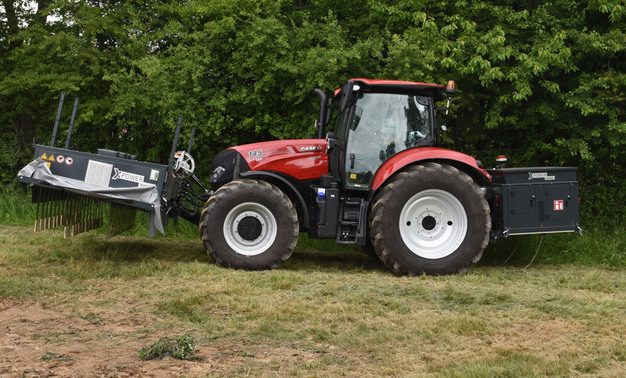
XPower with applicator in front and electric generator in the back
Grasskiller for band application
This machine, made by Dröppelmann (www.droeppelmann.de) kills weeds with cold water at a pressure of 1000 bar. A jet of water penetrates the ground about 3-6 cm deep. With electro-hydrostatical steering the rotary head works within the rows of trees. The machine uses 0.3 l water per meter. Within a tank, it carries a supply of 2000 l water.
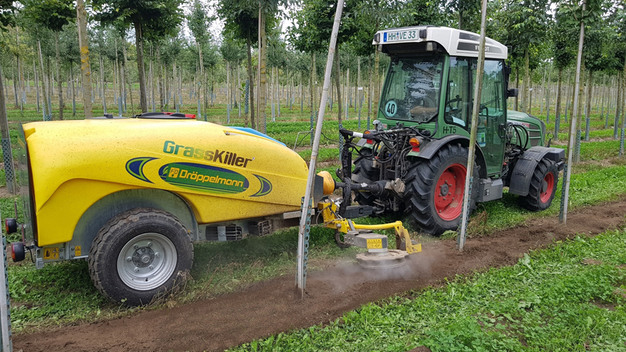
Grasskiller, alternative weed control with cold water
Soil disinfection
Optimized Soil Steamer
The trailed soil steamer of the company Mobildampf.de (www.mobildampf.de) works successfully in German, Swiss and Austrian nurseries for several years. Some of the difficulties of the machine were a large turning radius, not enough directional stability and the hydraulically operated spike harrow's susceptibility to damage. The companies Mobildampf.de and Zorn Sondermaschinenbau (www.zorn-sondermaschinenbau.de) improved these weak spots. The newly designed machine uses the proven steam generator of the company MSD (www.moeschle.de).
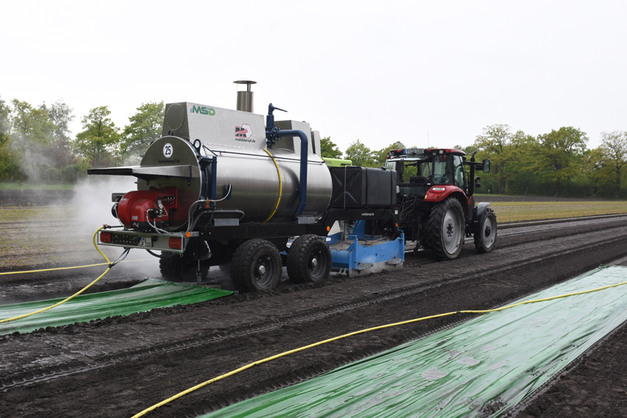
The newly designed soil steamer of Zorn Sondermaschinenbau and Mobildampf.de
Forigo Sterilizer for Application of Basamid
Machine specialized in the application of solid fumigants into the soil with stone burier base and professional stretching of the plastic layer on beds’ surface in one step. The machines can be delivered with different working width from 110 cm. After removal of the plastic cover, seeds can be sown directly upon beds without further tillage. Producer – Roter Italia (www.forigo.it).
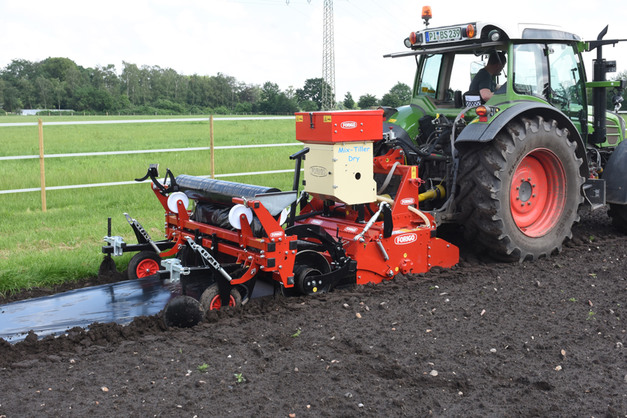
Forigo Mix Tiller Dry
Application of pesticides
ASM - single-arm air assistant boomsprayer
Single-arm air assistant folding boom sprayer with maximum arm of 12 m. Especially made for container nurseries and higher crops in the field. The tractor for carrying the sprayer should have 80 to 100 PS and being able to deliver at least 60-80 l/minute for running the blower. The equipment is presented by ASM Østervang of Denmark (www.asm-ostervang.dk).
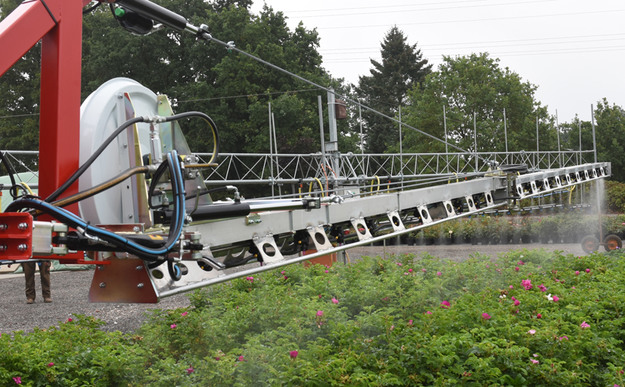
ASM single-arm air assistant boom sprayer
Tractor mounted precision-guided row crop equipment for three beds
With this machine, three beds can be sprayed between rows simultaneously. Even though planted by GPS, there are small deviations in distance between rows and beds. To overcome the uneven planting, the unit for each bed is controlled separately with the help of a mechanical sensor. The sensor sends a signal to a hydraulic cylinder which steers the tool. The machines of two Dutch companies – Elco machinebouw B.V. (www.elco-machinebouw.nl) and Schrauwen Machinebouw Zundert (www.s-m-z.nl) – work in the same way and are therefore presented together.
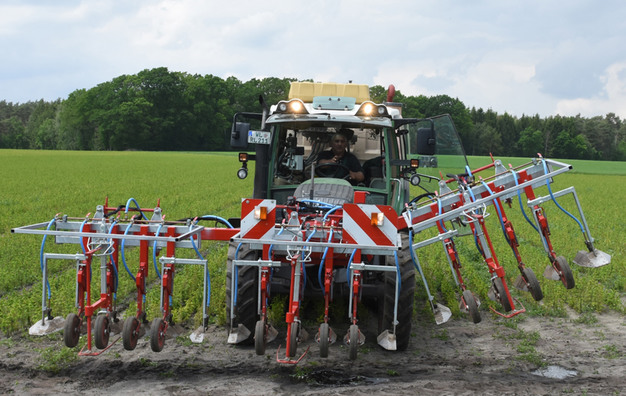
Tractor mounted shielded sprayer for three beds
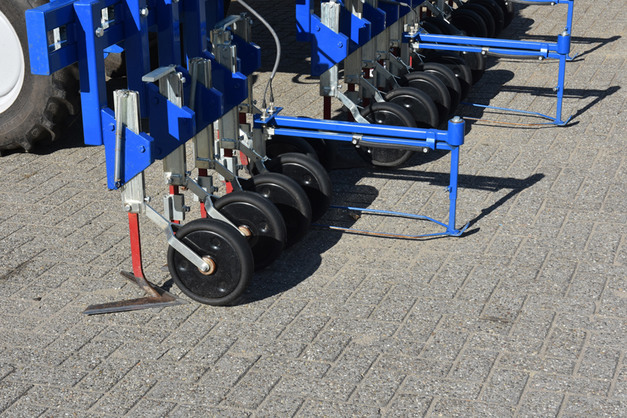
Precision guided hoes row crop equipment for three beds
Drones
DJI MG-1S Agras-specialized drone for Agriculture and Horticulture
Drones in agriculture and horticulture are mainly used to monitor plants. Professional drones with larger lifting capacities and longer flight time are rare. DJI is the company who specialise in manufacturing drones for agriculture. The German distributor is Solectric (www.solectric.de). The drone DJI MG-1S Agras has a lifting capacity of 10 kg and can work for 22 minutes. It can be equipped with standard jets from Teejet. Country-specific regulations must be adhered to.
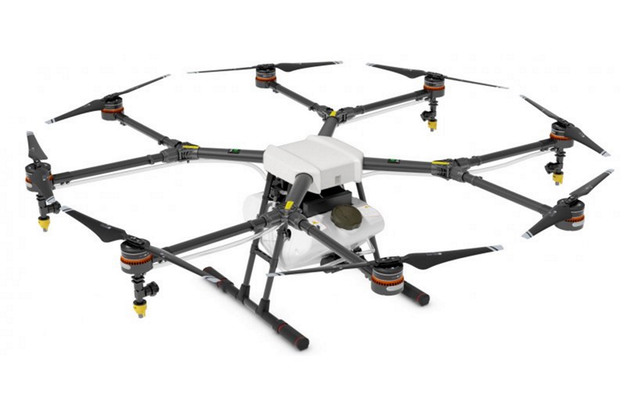
Agricultural drone DJI MG 1S Agras applies fertilizers and pesticides
Robots - autonomous devices
Naio Oz – autonomous tool for cultures in row
For several years this small robot of the French company Naïo Technologies (www.naio-technologies.com), 100 x 45 x 60 cm and a weight of 150 kg is sold already. It is powered by electrical motors with rechargeable batteries and can work 3-10 hours. The machine can autonomously do cultivation work on fields with inter-row distances of 60 cm and more. Steering is done by lasers and camera systems.
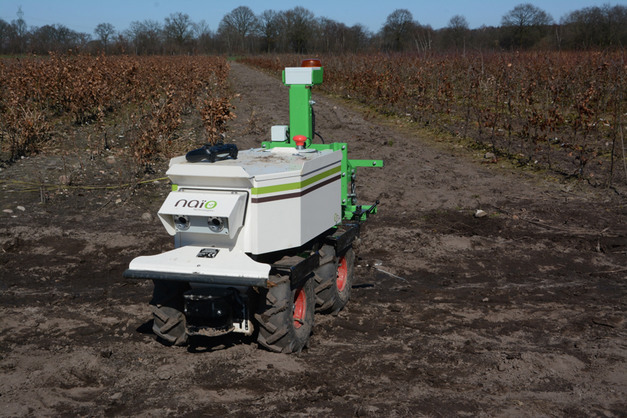
Robot Oz (Naïo company) at work
Naio Dino – autonomous robot for bed cultures
The carrier Dino is mainly designed for mechanical weeding of vegetable crops on beds 1.8 m wide. It can be converted to the standard bed width of 1.5 m used in nurseries. Depending on the rechargeable battery and the mounted tools the machine can work 4-8 hours. It moves autonomously on fields with the help of cameras and GPS. Detecting and destroying single weeds is not possible yet. Presented by Naïo Technologies of France (www.naio-technologies.com).
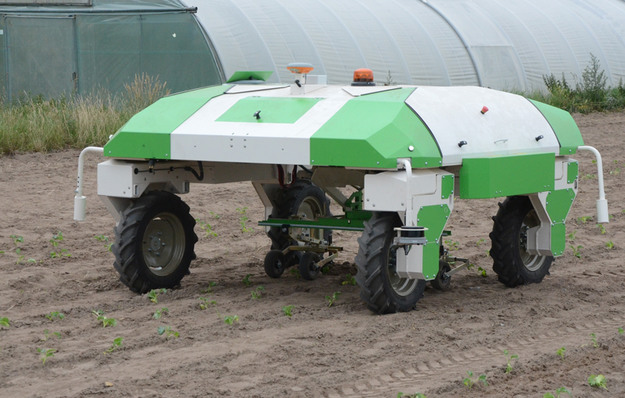
Dino at work in vegetable cultures
Robot HV 100
Autonomous robot of the American company Harvest Automation (www.public.harvestai.com), which is designed to perform material handling tasks in unstructured, outdoor environments such as putting pots down or moving them. Local sensing technologies that do not depend on GPS recognize pots or obstacles and measures distances between pots. The robot can handle pot sizes from 13 to 32 cm diameter and can move up to 240 pots per hour. Its lifting capacity is 10 kg. It works 4-6 hours with one battery load and it weighs 50 kg.
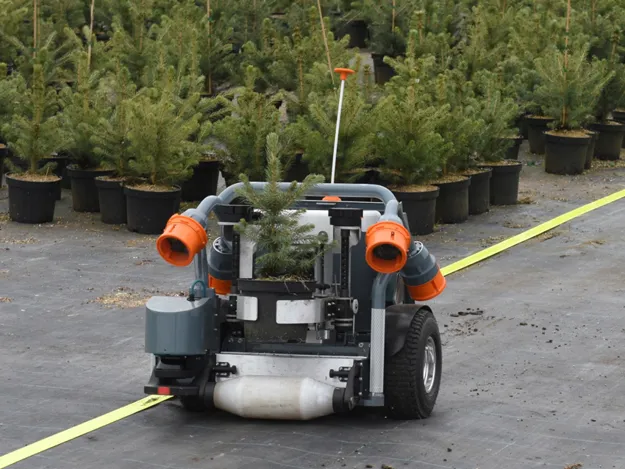
Robot HV 100 transports pots in a nursery
Trooper nursery robot
The Trooper nursery robot of the French company INSTAR Robotics (www.instar-robotics.com) is a prototype of an autonomous robot that can move and transport container plants. The robot is able to carry up to six plants at any one time on the above-attached platform.
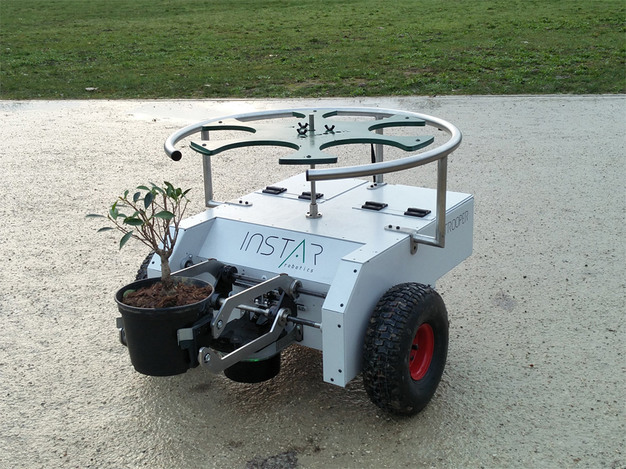
Trooper nursery robot
RowCropPilot
Robot Makers – the German company located in Kaiserslautern (www.robotmakers.de) – equips vehicles of other manufacturers like Aebi (www.aebi.at) or Damcon (www.damcon.nl) with intelligent steering technology to work autonomously. Instead of depending upon GPS Signal the RowCrop Pilot works with a complex laser scanner. Row Crop Pilot enables machines to mow or do band spray applications autonomously.
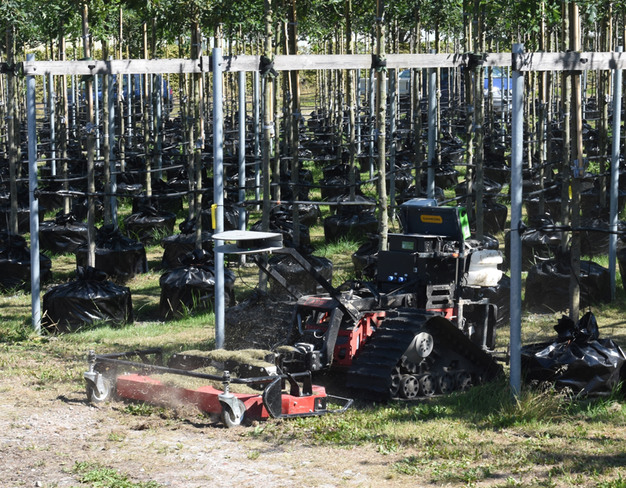
Mulcher of the company Aebi steered by a laser of Robot makers
Automatic grading
Automatic Grading of woody plants
Grading is still one of the most time-consuming jobs in production. GEJO Grading is the only manufacturer who currently offers a fully developed machine. The process is restricted to broadleaved plants. The Belgian company SMO bvba (www.smo.be) together with the Belgian nursery Sylva present the prototype of a new machine at “Baumschultechnik”. The machine measures 12 x 15 m and sorts 4000-6000 seedlings per hour via picture data processing by criteria length and diameter.
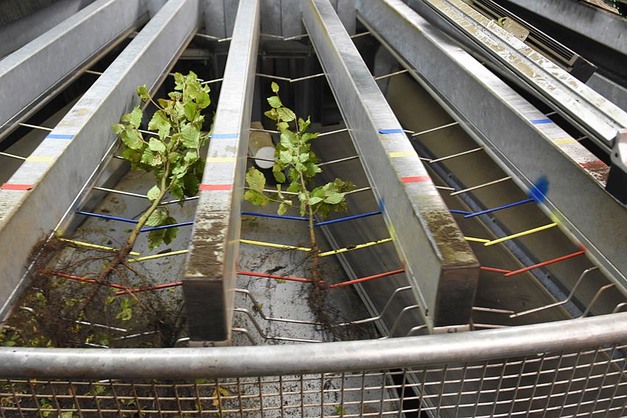
Fagus sylvatica before grading via picture data processing
Multi-equipment carriers
Flunick, autonomous multi-equipment carrier
The multi-equipment carrier is built as a crawler-type vehicle by nursery owner Andreas Reichenbach from Switzerland (www.baumschulen-reichenbach.ch). The track gauge can be adjusted between 1.5 and 2.5 m. The distance between rows of plants should be at least 50 cm. Plants up to 2.3 m can be straddled. Flunick is powered by two independent Diesel engines. There is no driver’s seat, the machine is steered by remote control or automatically by GPS. Flunick is suited for mechanical weed control, fertilization or other applications (www.semesis.ch).
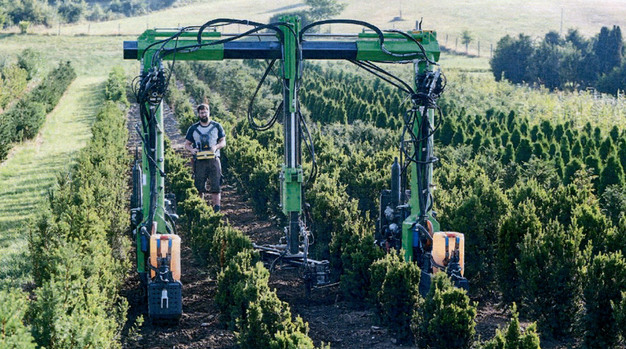
Multi equipment carrier in action
Multi-equipment carrier as crawler-type vehicle
Minimizing pressure on soil and the possibility of working on the boggy ground were the goals of developing this multi-equipment carrier. All standard nursery tools can be mounted on this tractor. With GPS these tools eg. soil auger, can be used. It is forwarded electronically and hydraulically and has a maximum travel speed on roads of 15 km/h. This machine is individually manufactured by customer’s request. Presented by Ezendam Rijopleidingen of the Netherlands (www.ezendam.nl).
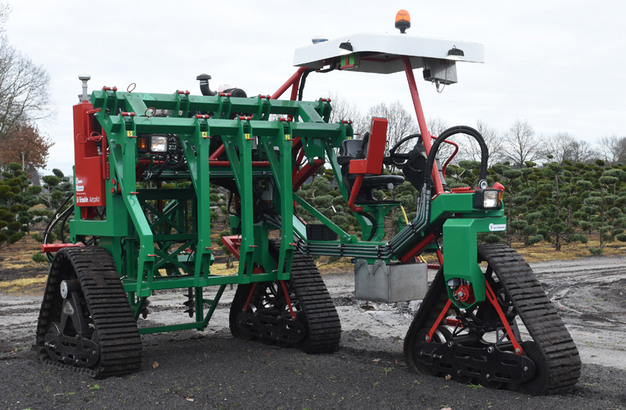
Multi-equipment carrier as crawler-type vehicle
“Nurserymachinery/Baumschultechnik 2019”
The “Nurserymachinery/Baumschultechnik 2019” will be held at the Horticulture Centre (Gartenbauzentrum), Thiensen 16, 25373 Ellerhoop, Germany. The organizers of the event are: Landwirtschaftskammer Schleswig-Holstein, Versuchs- und Beratungsring Baumschulen e.V., Landesverband Schleswig-Holstein im Bund deutscher Baumschulen e.V.
For more information:
Nurserymachinery/Baumschultechnik 2019
Phone: 0049 4120-7068-301
Fax: 0049 4120-7068-319
E-Mail: info@baumschultechnik.de
Exhibition manager: Dr. Heinrich Lösing
www.nurserymachinery.com, www.baumschultechnik.de
